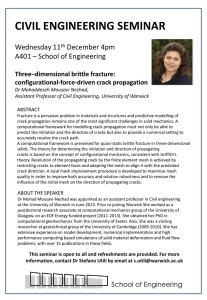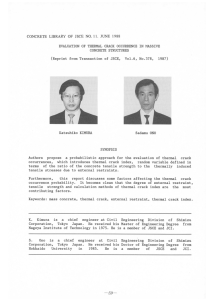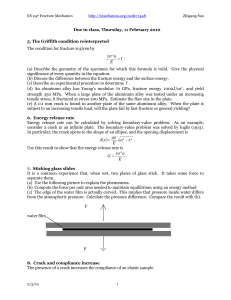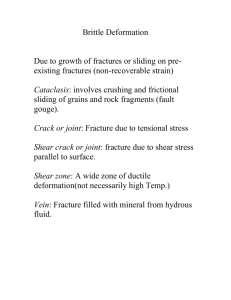DAMAGE EVOLUTION BY ACOUSTIC EMISSION METHOD IN THE FRACTURE
advertisement
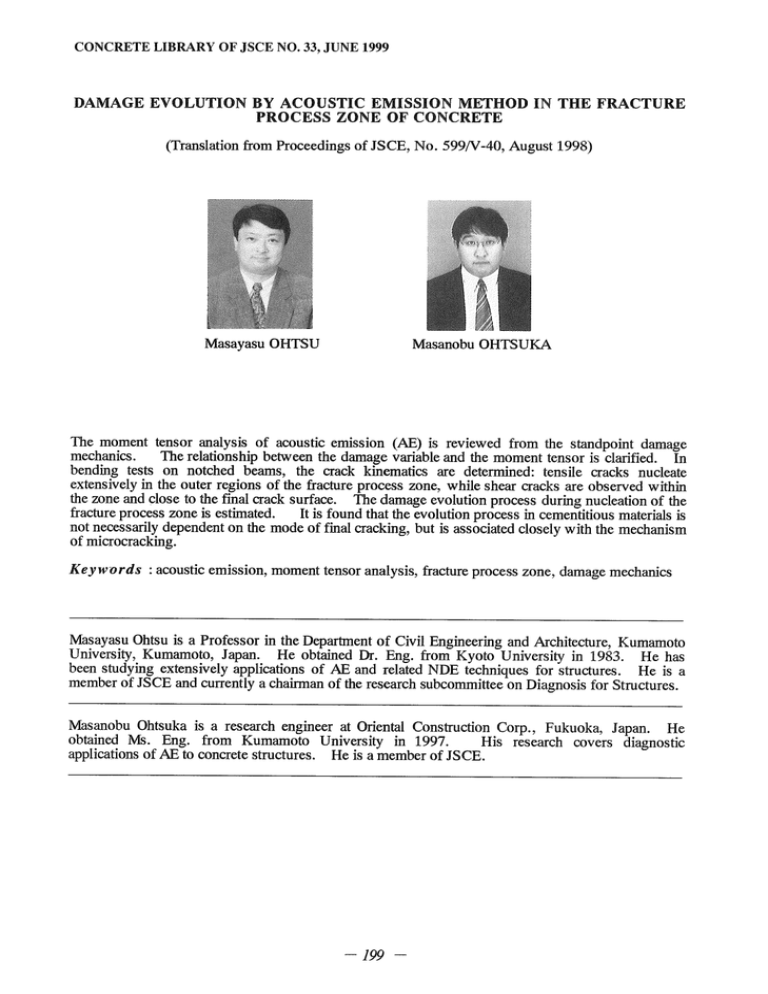
CONCRETE LIBRARY OF JSCE NO. 33, JUNE 1999 DAMAGE EVOLUTION BY ACOUSTIC EMISSION METHOD IN THE FRACTURE PROCESS ZONE OF CONCRETE (Translation from Proceedings of JSCE, No. 599/V-40, August 1998) I. .. 3 Masayasu OHTSU Masanobu OHTSUKA The moment tensor analysis of acoustic emission (AE) is reviewed from the standpoint damage mechanics. The relationship between the damage variable and the moment tensor is clarified. In bending tests on notched beams, the crack kinematics are determined: tensile cracks nucleate extensively in the outer regions of the fracture process zone, while shear cracks are observed Within the zone and close to the final crack surface. The damage evolution process during nucleation of the fracture process zone is estimated. It is found that the evolution process in cementitious materials is not necessarily dependent on the mode of final cracking, but is associated closely with the mechanism of microcracking. Keywords : acoustic emission, moment tensor analysis, fracture process zone, damage mechanics Masayasu Ohtsu is a Professor in the Department of Civil Engineering and Architecture, Kumamoto University, Kumamoto, Japan. He obtained Dr. Eng. from Kyoto University in 1983. He has been studying extensively applications of AE and related NDE techniques for structures. He is a member of JSCE and currently a chairman of the research subcommittee on Diagnosis for Structures. Masanobu Ohtsuka is a research engineer at Oriental Construction Corp., Fukuoka, Japan. He obtained Ms. Eng. from Kumamoto University in 1997. His research covers diagnostic applications of AE to concrete structures. He is a member of JSCE. -199 *" 1. INTRODUCTION Acoustic emission (AE) is an inspection technique in which elastic waves generated in a material are detected. It has been confirmed that in concrete AE waves due to cracking can be synthesized by the dislocation mode[l]. Dislocation (crack) motion consists of kinetics and kinematics. In source characterization of AE, crack kinetics is represented by a source-time function which can be determined by deconvolution analysis[2]. Crack kinematics at the AE source is defined by the crack motion vector (Burgers vector) and the unit vector normal to the crack plane. Combined with the elastic constants, the product of the two vectors leads to the moment tensor. A simplified and stable procedure has been developed to determine momenttensor components from AE waveforms[3]. Based on an eigenvalue analysis of the momenttensor, a generalized treatment for the classification of crack type and the determination of crack orientation is now implemented as the SiGMA (simplified Green's functions for moment tensor analysis) code[4]. The procedure has been successfully applied to fracture tests of concrete[5], [6], [7], Elsewhere, a similar procedure has been reported[8] but is limited to the two-dimensional (2-D) problem, for which the SiGMA-2D code is available[9]. In order to apply fracture mechanics to the fracture modes of concrete structures, the nucleation of the fracture process zone ahead of the crack tip has been intensively studied[10]. Recently, also fracture mechanics has been extended to cover continuous damage mechanics[11]. In this paper, the relation between the damage variables and the momenttensor components is clarified. In bending tests on notched beams, crack kinematics and damage evolution in the fracture process zone are estimated by momenttensor analysis using SiGMA. 2. MOMENTTENSOR AND DAMAGEVARIABLES Mathematically, crack kinematics can be modeled using crack motion vector b(y, n normal to crack surface F, as shown in Fig. 1. Vector b(y,t) is referred to b(y) represents the magnitude of crack displacement, I is the direction vector S(t) is the source-time function of crack nucleation. The following integration leads to a product of the momenttensor mpqand the source-time function S(t): à"T F cpqki [b(y)lkS(t)] n, dS = [Cpqkl ^Dj [ J" Fb(y) t) and the unit vector as b(y)lS(t), where of crack motion, and over crack surface F dS]S(t) =[Cpqkl lkn1] AV S(t)= mp(1 S(t), (1) where Cpqklis the tensor of elastic constants and AV is the crack volume. The elastic displacement ui(x,t) = Gip)q(x,y,t) u(x,t) material, represents AE wave[3], mpq * S(t). Here Gip>q(x,y,t) are the spatial convolution operation. In an isotropic due to crack motion b(y,t) derivatives (2) of Green's functions and the symbol * denotes the the momenttensor m^is derived from eq. (1), mpq=[cpqki liA] Av= [*Vk + JAlpV^nJAV, (3) where A, and (JL are Lame constants. The product of crack vector b(y)lk and crack normal ^ is referred to in micromechanics as the eigenstrain [12]. Similarly, in damage mechanics, the secondorder damage tensor eP^ is defined[13] as, -200 ~ AE sensor n AE sensor AEsource </« fJ AE waves crack surface F momenttensor crack motion Fig. 1 Crack nucleation and AE waves. BPkl = 1/V* 2 AF (bkn, + b,nk)Ö/2, Fig. 2 Configuration (4) where V* is the representative volume and AF is the area of one crack. one crack, the damage tensor Elkl for one crack is derived from eq. (4), Elkl =1/V* J F([b(y)lk] n,+[b(y)\] The scalar damage variable D = nk Elkini nk)dS /2 = AV(lkn, for one crack D is readily = AV/V* of AE sensors and AE source. obtained Taking into account only + 1^)/2V< (5) as, (6) lknk. From eq. (3), a trace component is obtained, mkk = (3X.+2M) Consequently, (7) lknkAV. the damage evolution can be represented as, 2 Dco= 1/V*2 [AVlknk](i) = 1/[V*(3U2H)]2 mkk(i). (8) This implies that the damage evolution process can be estimated in relative terms from the accumulation of trace components of the momenttensors. Also, the relative crack volume can be obtained from eq. (7) as, (3U2fi) 3 . SiGMA (9) AV = mkk/ [lknk]. PROCEDURE In the SiGMA code, eq. (2) is simplified, of AE wavefrom in the far field, A(x) = Cs /R Ref(t,r) where Cs is the calibration taking into account only the amplitude rp mpqrq, coefficient. of first motion A(x) (10) As shown in Fig. 2, t is the direction -201 - of sensor sensitivity. R is the distance from the AE source at point y to the AE sensor at point x. rp is its direction vector. Ref(t,r) is the reflection coefficient. Since the moment tensor is symmetric and of the second order, the number of independent unknowns m^ is six. A multi-channel observation of first motions at morethan six sensor locations can provide sufficient information to solve eq. (10). Prior to the analysis, the calibration the sensitivity of the AE sensors. into three ratios X, Y, and Z[4], 1.0 = coefficient Cs in eq. (10) should be determined to compensate for Three eigenvalues are then normalized and uniquely decomposed X+Y+Z, the intermediate eigenvalue/the maximum = 0-Y/2+Z, the minimum eigenvalue/the (ll) maximum =-X-Y/2+Z, where X, Y, and Z denote the shear ratio, the deviatoric tensile ratio, and the isotropic tensile ratio, respectively. AE sources for which the shear ratios X are smaller than 40% are classified as tensile cracks. AEsources of the shear ratio X greater than 60% arereferred to as shear cracks. In cases between 40% and 60%, the AE source is classified as mixed-mode. In the SiGMAcode, unit vectors e15 e2 and e3 corresponding to the three eigenvectors 1 + n, 1 x n, and I - n are determined. Therefore, vectors 1 and n can be recovered from the following relations, l = (2 + 21knJ^e1 n = (2 + 21knk)1/2e1 + (2 - 21knk)^e3, - (2 - 21knk)1/2e3. (12) 4. EXPERIMENTS 4.1 Bending Tests The flaw location procedure was successfully applied to identify the fracture process zone in concrete[14]. Because the SiGMA procedure provides information on crack types and crack orientation, in addition to crack location, crack nucleation in the fracture process zone is investigated. Mortar and concrete specimens of dimensions 10 cm x 10 cm x 40 cm were cast and cured in water for 28 days in astandard room (20°C). Mixture proportions are given in Table 1. The maximum size of coarse aggregate is 20 mm, and the fine aggregate is commonto both of concrete and mortar mixes. Mechanical properties are indicated in Table 2. These were determined from cylindrical specimens of 10 cm in diameter and 20 cm in height at the age of 28 days. Although the strength of mortar is comparable to that of concrete, Young1s modulus and P-wavevelocity of mortar are lower than those of concrete. Three-point bending tests were conducted. At the age of 28 days, a sawed pre-cracked notch of 3 cm depth and 1 mmwidth was introduced in each specimen. The types of specimen included a centernotched beam under center loading (type CC), and an off-center notched beam under center loading (type OC). The experimental set-ups and AE sensor locations are shown in Fig. 3. Six AE sensors were arranged to cover the area of the fracture process zone to be nucleated. In the figures, open circles indicate AE sensors located on the back face and solid circles those on the front face. All sensors have a resonant frequency of 150 kHz. They were relatively calibrated so as to obtain equivalent sensitivities beforehand. The measured frequency was 10 kHz - 1 MHz and a total 60 dB gain for amplification was employed. AE waveforms occurred during crack extension were detected, amplified, filtered, and recorded using the LOCAN-TRAsystem (Physical Acoustics Corp.). Loads were measured with a loadcell 202 - u D Table 1 Mixture proportions w eig h (k t p ger/mu 3) n it m ass cc) cm ) (% ) ad m ix - slu m p a ir _ so so 7 IR I L 80 I, 80 120 X 2fl 60 m r AE w c s G i tu re c o n cre te 1 72 34 6 8 34 m o rtar 342 57 0 1140 102 1 104 8 .0 5 .0 u Ll iiJ -JLiu L u u L 70 -L iiU is (a ) ty p e C C (m m ) a 50 .7 T so n able 2 Mechanical properties co m p re s s iv e s t re n g t h (M P a) I te n s ile P o i- Y oung s P -w a ve s tr e n g t h ss o n s m o d u lu s v e l o c ity R a tio G P a) (M P a) 12.5 lii .^ ii J z aL (m / s ) saJ t c o n c r e te 5 2 .8 4 .1 2 0 .2 4 3 2 .5 4730 m o r ta r 5 3 .7 2 .9 3 0 .2 0 2 3 .4 4130 __2 fl 60 V ao .bI LI siu WI I n 'o -t J _ l fl (b) type OC Fig. 3 Experimental set-up and AE sensor array. and crack-mouth opening displacements (CMOD) were recorded using a clip gauge inserted into the notch. A servo-valve controlled machine was employed for loading. Specimens of type CC were prepared to trace the nucleation of the fracture process zone under mode-I cracking. In contrast, mixed-mode of mode-I and mode-II cracking was expected in type OC. Loading rate of 0.01 mm/min was applied to type CC specimens, whereas the rate applied to type OC specimens was 0.02 mm/min. This is because crack propagation in type CC was faster than that in typeOC. 4.2 WaveformAnalysis In order to solve eq. (10), the amplitude of the first motion should be read from AE waveform. In addition, the arrival time of the first motion needs to be determined to carry out location analysis. These two parameters of the arrival time and the amplitude of the first motion were read visually from each waveform as displayed on the CRT screen. From the AE waveforms at six locations, the locations and momenttensor components were determined. The crack types and crack orientations werethen analyzed. In order to estimate errors in the momenttensors, error analysis was performed with assumed location errors[4]. As a result, it was realized that accuracy was highly dependent on the geometrical configuration of the sensor array and the AE sources. This in turn implies that the solution accuracy is dependent on particular situation and may not be estimable by simple criteria. Furthermore, it was found that most errors were introduced by misreading the first motions. To select reliable solutions, therefore, a method of post-analysis was developed[15]. Theoretical AE waveforms at the AE sensor locations were synthesized, using data on the AE source location and the moment tensor components. The two parameters of each theoretical waveform were automatically read and the SiGMA code was applied again. Then, AE sources whose crack kinematics in post analysis werein good agreement with those of the SiGMA analysis were selected as reliable solutions. -203 - (a) type CC : concrete Table 3 The number of AE hits analyzed to l a c le a r S G M A p o s t- A E h i ts reco rd s a n a ly z e d a n a ly s is 205 17 7 137 36 .t y p e O C 515 2 12 143 29 m o rt a r ty p e C C 2 54 20 7 147 43 ty p e O C 975 60 9 409 10 2 0.4 0.6 CMOD(mm) (b) type OC : mortar o ty p e C C c on crete 0.2 CO 3° "-^ CN NJ £ o So «> o o5 *s 3° %>/acejne nt I 0.1 5. , I 0.2 , I 0.3 I 'I 0 .4 CMOD(mm) Fig. 4 Load-CMOD relations and Total AE counts observed under loading. RESULTS AND DISCUSSION The number of total AE hits detected in the tests is indicated in Table 3. An AE hit is defined as an AE event for which AE waveforms are simultaneously recorded on all channels. Amongthis AE hit data, however, not all first motions could necessarily be identified. Thus AE hits for which first motions were clearly recorded on all six channels were selected for analysis. The number of these data is denoted in the table. In the case of concrete type OC, morethan 50% ofAE hits were discarded. After SiGMA analysis, approximately half of the total AE hits reached solution except for concrete type OC. Eventually, in post-analysis, the number of data points further decreases to 10 - 20% of the total. This is a limitation of the feasibility of SiGMA analysis in its current state. AE events discarded in the analysis mostly result from unclear first motions and divergence in the location routine. The situation might be improved by introducing automated first-motion reading[8]. In contrast to AE hits, AE counts are defined as the number of AE occurrences recorded on one channel. In Fig. 4, AE counts observed by the AE sensor on channel 1 are plotted against CMOD, along with the load-displacement curve. Concrete type CC, as shown in Fig. 4 (a), is a typical result. After the peak load, AE activity suddenly increases and thus discontinuous jumps in AEoccurrence are observed. In concrete type OC, similar activity was found. This suggests that the cracking process in concrete is not continuous. As shown in Fig. 4 (b), in the case of mortar type OC, AE activity increases gradually with no relation to peak load. Although a slight increase in AE activity was seen at peak load in mortar type CC, the essential behavior of AE occurrence is similar to Fig. 4 (b). This implies that microcracks in the fracture process zone are generated continuously in mortar. The results of post analysis are plotted in Figs. 5 and 6. AE sources for which the shear ratios are smaller than 40%, and are therefore classified as tensile cracks, are indicated by the "arrow" (^) symbol, while other sources are indicated by the "cross" ( X ) symbol. -204 - type CC : concrete type OC : mortar サ" // X r'」/fy>/ ft * X / x * (V ^ *% ** wv V* -> -Jl* 1?* x f " ' * BI- 1 i * / / * * /* V' X * V* x V -V Plan view * Plan view x<=> mte nixs eiled -mc r oa cdke x // , / Ay p * sm h ixe aera c-mra co ka e * >* >ォ fr *.^ ** a& r ?* - x V < => tensile crack X mixed-mode H* ; x| shear crack V- N Elevation view X a + Elevation view Fig. 5 Crack locations, types and (mentations fi Qack locations t s ^ orientations determined in aconcretespecimen of 8 determmed^a^^ imenof ^ CCtype OC. AE sources are plotted at their locations with directing the two vectors 1 and n, which are determined from eq. (12). Previously, only the first eigenvectors ex were plotted for tensile cracks[4]. A recent study, however, clarifies that the angle between the two vectors I and n could be over 50°, even in a case where the shear ratio is smaller than 40%[16]. Consequently, the directions of the two vectors are given for all data. Naturally, the angle between the two vectors is considerably smaller for tensile cracks with the "arrow" symbol. In Fig. 5, the result for a concrete specimen of type CC is given. Surface cracks extending from the notch are indicated in the elevation view. These were observed at the front face and the back face. The final crack surface follows a tortuous path to the notch, and thus the direction of the tensile opening is inclined toward the notch according to the plan view. It seems that an AE cluster covers the fracture process zone and tensile cracks are observed in the outer regions of the zone. In Fig. 6, the result for a mortar specimen of type OC is shown. Surface cracks form diagonally from the notch to the loading point. Thus, mixed-mode crack propagation is observed. Along the final crack surface, there is an intense AE cluster. Under mixed-mode cracking, a wide region corresponding to the fracture process zone is observed. Again, tensile cracks are mainly observed far from the surface cracks and the cluster of shear cracks. To confirm the apparent trend in AE location, AE sources are projected onto the x-y plane in Fig. 3. The case of a concrete specimen of type OC is shown in Fig. 7. Cracks are classified into tensile, mixed-mode, and shear cracks. The locations of surface cracks are denoted by open circles. The -205 - (a) V4 J3 2 , o > og type OC : concrete <u BK >3= l 03 o .O 0 5 tensile crack mixed-mode shear crack A^ ^ type CC : concrete I I (T M O - C * + . O jy > -f w o * 1 I m I k k / lk n k . te n s i le c r a c k A m ix e d -m o d e sh e a r crac k D 2 m kk D o B 1 0 , 10 0 1 2 0 0 , AE hit number (b) type OC : mortar 3.0 7.0 y-axis (cm) Fig. 7 Projection of AE locations type OC. in concrete O h^JEDDCarBr! 500 1000 AE hit number Fig. 8 Damage evolution and the accumulation of crack volume. final crack extends from left to right. Most of the tensile cracks are observed further from the surface cracks than mixed-mode and shear cracks, which are observed close to the surface cracks. Similar results were also obtained in the other cases. This demonstrates that tensile cracks nucleate in the outer regions of the fracture process zone, while other types of cracks are generated intensely within the process zone. Damage evolution was estimated using eq. (8). The accumulation of crack volume was also estimated from eq. (9). In Fig. 8, results for concrete type CC and mortar type OC are plotted. The trace of the momenttensor was directly calculated from the experimental results. Consequently both the scalar damage mkkand the variable mkk/lknk corresponding to the crack volume are relative. The accumulation of these values is plotted against the number of AE hits. Although the cracks are categorized, three types of cracks are generated in so much confusion that the dominant type cannot be identified in the accumulation process. As seen in Fig. 8 (a), damage evolution and the accumulation of crack volume rise discontinuously. According to Fig. 8 (b), the damage evolution in mortar is fairly continuous although a slight step increase is observed in the accumulation of crack volume. Taking into account the difference in AE activity shown in Fig. 4, the discrepancy in damage evolution might result from the presence of the coarse aggregate in concrete specimens. The steplike increases in damage and crack volume possibly correspond to bonding failures between coarse aggregate and the mortar matrix. In type CC specimens, mode I cracking was expected, while mixed-mode cracking was suggested in type OC. This difference in damage evolution process was, however, not clear in concrete. The evolution process was always step-like discontinuous. On the other hand, damage evolution of mortar was observed to be continuous as nucleation of the fracture process zone proceeded. This implies that damage evolution in the fracture process zone of cementitious materials is not necessarily dependent onthe final crack mode, but is responsible for the nucleation of microcracking. -206 - 6 . CONCLUSION By applying moment tensor analysis to AE, the damage evolution process during nucleation of the fracture process zone is estimated in concrete and mortar. The conclusions reached are as follows: (1) Although specimens were prepared for mode-I cracking and for mixed-mode cracking, the cracking process (AE generation) in both cases is observed to be not continuous in concrete. In contrast, microcracks are generated continuously in the fracture process zone of mortar. (2) From SiGMA analysis, it is found that tensile cracks appear further from the surface cracks than mixed-mode and shear cracks. This demonstrates that tensile cracks nucleate in the outer regions of the fracture process zone, while shear cracks are generated within the zone and close to the final crack surface. (3) In concrete, damage evolution in the fracture process zone is step-like discontinuous, while in mortar it is almost continuous. The difference between mode-I cracking and mixed-mode cracking in the damage evolution process is not clear. This implies that damage evolution in cementitious materials is not necessarily dependent on the mode of final cracking, but is rather associated closely with the nucleating mechanism of microcracking. References [I] Ohtsu, JournalofAE, M.r Source Mechanism Vol.2, No.1, and 103-112,1982 WaveformAnalysis of Acoustic Emission in Concrete, [2] Wadley, H. N. G., and Scruby, C. B. : Acoustic Emission Source Characterization, Advances in Acoustic Emission, Dunhart Publishers, Knoxville, 125-153, 1981 [3] Ohtsu, M: Mathematical Theory of Acoustic Emission and Moment Tensor Solution, Journal of the Society of Materials Science, Japan, Vol. 36, No. 408, 1025-1031, 1987 [4] Ohtsu, M. : Simplified Moment Tensor Analysis and Unified Decomposition of AE Source, Journal of Geophysical Research, Vol. 96, No. B4, 6211-6221, 1991 [5] Ohtsu, M, Shigeishi, M., and Iwase, H.: AE Observation in the Pull-Out Process of Shallow Hook Anchors, Proc. JSCE, No. 408/V-H, 177-186, 1989 [6] Suaris, W. and van Mier, J. G. M.: Acoustic Emission Source Characterization in Concrete under Biaxial Loading, Materials and Structures, No. 28, 444-449, 1995 [7] Yuyama, S., Okamoto, T., Shigeishi, M., and Ohtsu, M.: Acoustic Emission Generated in Corners of Reinforced Concrete Rigid Frame under Cyclic Loading, Materials Evaluation, Vol. 53, No. 3, 409-412, 1995 [8] Ouyang, C., Landis, E., and Shah, S. P.: Damage Assessment in Concrete using Quantitative Acoustic Emission, Journal of Engineering Mechanics, ASCE, Vol. 117, No. 1 1, 2681-2698, 1991 [9] Shigeishi, M. and Ohtsu, M.: Acoustic Emission Waveform Analysis in Two-Dimensional Models, Journal of the Society of Materials Science, Japan, Vol. 45, No. 9, 1055-1060, 1996 [10] Mihashi, H. : State-of-the-Art Report on Fracture Mechanics Applied to Reinforced Concrete Structures, Concrete Journal, JCI, Vol. 34, No. 5, 5-15, 1996 [II] Shah, S. P., Swartz, S., and Ouyang, C. S.: Fracture Mechanics of Concrete, John Wiley & Sons, Inc., New York, 1995 [12] Mura, T.: Micromechanics of Defects in Solids, Martinus Nijhoff Publishers, The Hague, 1982 [13] Kachanov, M : Effective Elastic Properties of Cracked Solids : Critical Review of Some Basic Concepts, Applied Mechanics Reviews, Vol. 45, No. 8, 304-335, 1992 [14] Nomura, N., Mihashi, H., and Niiseki, S.: Influence of Coarse Aggregate Size on Fracture Energy and Tension Softening of Concrete, Concrete Research and Technology, JCI, Vol. 2, No. 1, 57-66,1991 [15] Ohtsu, [16] Ohtsu, M.: Acoustic Emission Theory for MomentTensor Analysis, Journal M.: Post-Analysis of JSNDI, Evaluation, Vol. of SiGMA Code for Acoustic 43, No. 12, 776-782, No. 6, 169-184, 1994 1995 -207 - Emission Moment Tensor Analysis, Research on Nondestructive




